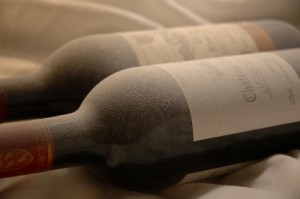by Lorri | Apr 3, 2013 | Tips, UnCorked
 I am sure we could search century-old cellar journals and find early versions of the longstanding question of when is the best time to open a bottle of wine. It’s really rather a conundrum because if you pull the cork too early you’re left with a tannic, acidic wine. Open too late and most likely nothing is left except a dried-out fruitless wine. And worse, if you open years past the appropriate life of the wine you’re stuck with a bottle of vinegar.
I am sure we could search century-old cellar journals and find early versions of the longstanding question of when is the best time to open a bottle of wine. It’s really rather a conundrum because if you pull the cork too early you’re left with a tannic, acidic wine. Open too late and most likely nothing is left except a dried-out fruitless wine. And worse, if you open years past the appropriate life of the wine you’re stuck with a bottle of vinegar.
I wish there was a magic calculation to come up with the right date to open our slumbering bottles. But that magic formula doesn’t exist. So, I offer these general guidelines for those who are questioning whether to pop the cork, or not.
Many wines are saved long past their viable life simply because of the owner’s perception of the wine label. I am asked a lot to quickly survey a collection and to offer advice regarding when certain wines are (or will be) ready to drink. A recurring theme is that the attractive French Bordeaux label leads owners – many of whom receive the bottles as gifts – to think they have a wine that should be aged longer than is necessary. A general rule is French labels stating the general and broad category of “Bordeaux AC” are best consumed within one to two years.
Opening any bottle that has been aging is a hit or miss proposition, especially if you only have one bottle. If you are serious about collecting I recommend buying by the case or at least three bottles. This helps you to determine exactly where the wine is in its maturity and offers you the opportunity to taste it in stages. If you have a case, open one bottle soon after you buy it so you have an indication of where the wine is in the aging process. Take notes and re-visit another bottle later to see how the wine is changing.
Red wines generally agewell because of tannins, the chemical substance that creates the pucker power in a young red wine, which has preservation properties. But keep in mind it’s a myth that a harsh tannic, unbalanced red wine only needs to be kept long enough to become a great wine. The same wine five years down the road will likely still be harsh and unbalanced. The same is true of the widespread thinking that young red wines in balance will not improve or change with time.
Color is one of the best gauges for red or white wines. If you are looking at a young red wine (depending on the grape) it will generally have a more purple rim color. As the pigments oxidize they are precipitated along with the tannins becoming more ruby and then gradually a brownish color. Storage conditions, the grape and method of production can also have color impact.
FOR NOW
- 2010 Swinto Old Vine Malbec, Argentina (about $40 retail) to keep for a couple of years.
FOR LATER
- 2007 Bell Vineyards Clone 6, California (about $80 retail) to taste now and until perfection, approximately 8 to 10 years.
by Lorri | Jan 2, 2013 | UnCorked
 This will be a two-part column about recommended wines to stock in order to have a variety on hand.
This will be a two-part column about recommended wines to stock in order to have a variety on hand.
The idea of starting your own wine collection or filling a cellar is very intimidating for most of us. But keep in mind only a minuscule percentage of wine drinkers are actually buying and investing in fine wines to age and cellar for extended lengths.
Most of us are simply interested in buying wines to drink and enjoy while taking advantage of the convenience of selecting a bottle at home rather than making a special trip to the wine shop for every occasion.
Many readers ask me what wines I recommend for keeping a case on hand or what I would select for starting a collection. I think a great place to start is with a variety of wines from light to fullbodied, sweet to bubbly, and wines for many occasions. You don’t have to have a cellar to begin collecting. It can start with a wine rack, corner of the refrigerator or even the back of your closet.
SPARKLING
If you are ever stumped or in doubt about which wine to pair with your creation, grab a bottle of bubbly. Sparkling styles are extremely versatile to have on hand, whether for toasting a special occasion or serving with salty or fried appetizers or just about any entree you could craft. I also like to keep a bottle or two on hand for a great last-minute hostess, birthday or anniversary gift. There’s no need to spend a lot, because there aremany values ranging from $10 to $20 a bottle with excellent quality.
- NV Piper Sonoma Brut Sparkling, California (about $15 retail)
WELL-ROUNDED WHITE
The go-to bottle for salads, seafood, vegetables and most cheeses is sauvignon blanc. This crowd-pleasing wine has a refreshing acidity, light body and tropical fruity taste.
- 2011 Honig Sauvignon Blanc, California (about $16 retail) BLUSHING BEAUTY
Many of you already knowmy thought on rose wines is that they are very underrated. This incredibly versatile style should be part of everyone’s case on hand. It is appropriate for the most formal occasion or an outside picnic and can pair with meats ranging from light to dark. The key is staying with a dry or off-dry choice.
- 2011 Cline Vineyards Rose, California (about $15 retail)
WHERE THERE’S SMOKE
For avid grillers, syrah/shiraz is must-have in the collection. It’s as if this wine was created solely for full-bodied, earthier red meats and other foods cooked over an open flame.
- 2010 Wyndham Estate Shiraz Bin 555, Australia (about $14 retail) COMFORTABLY RED
If for no other reason than its familiarity for guests, a cabernet sauvignon is important to have on hand. It matches well with hearty meats and pasta dishes and soups and cheeses. I keep a few bottles on hand to serve as an option as a quick gift.
- 2010 Liberty School Paso Robles Cabernet Sauvignon, California (about $15 retail)
PLAYS WELL WITH OTHERS
Wine experts and chefs agree: Pinot noir is the ultimate food-friendly red wine. Also it’s an ideal wine for dinner menus where red meat and fish are being served.
- 2010 Estancia Paso Robles, California (about $14 retail)
 I am sure we could search century-old cellar journals and find early versions of the longstanding question of when is the best time to open a bottle of wine. It’s really rather a conundrum because if you pull the cork too early you’re left with a tannic, acidic wine. Open too late and most likely nothing is left except a dried-out fruitless wine. And worse, if you open years past the appropriate life of the wine you’re stuck with a bottle of vinegar.
I am sure we could search century-old cellar journals and find early versions of the longstanding question of when is the best time to open a bottle of wine. It’s really rather a conundrum because if you pull the cork too early you’re left with a tannic, acidic wine. Open too late and most likely nothing is left except a dried-out fruitless wine. And worse, if you open years past the appropriate life of the wine you’re stuck with a bottle of vinegar. This will be a two-part column about recommended wines to stock in order to have a variety on hand.
This will be a two-part column about recommended wines to stock in order to have a variety on hand.